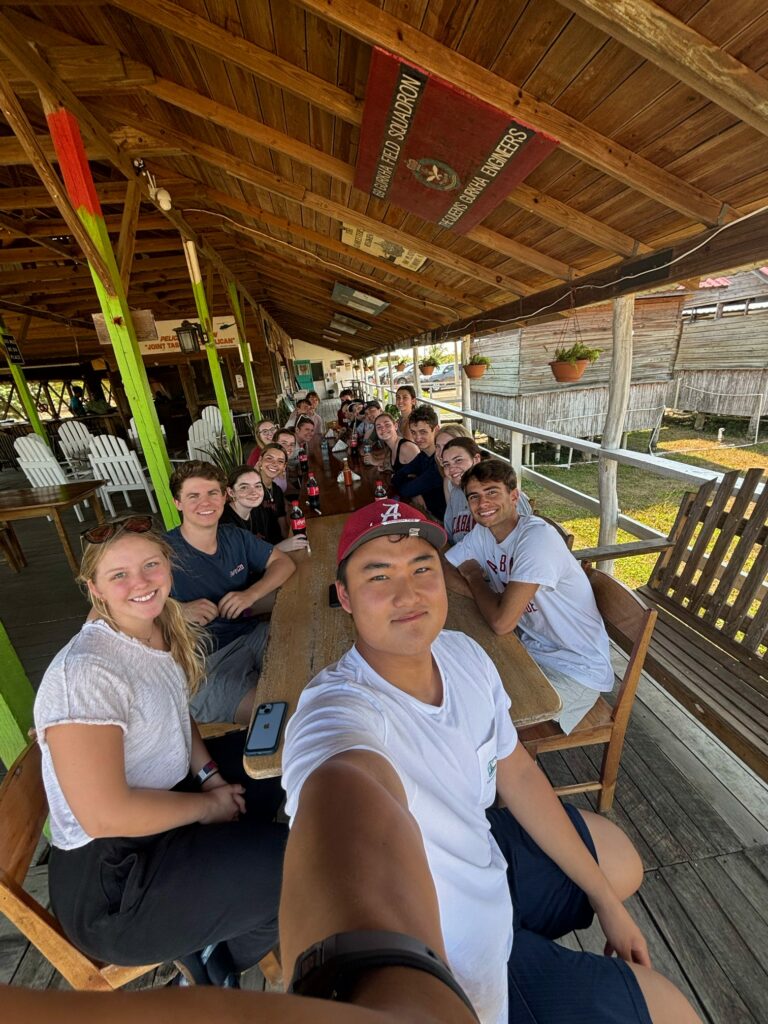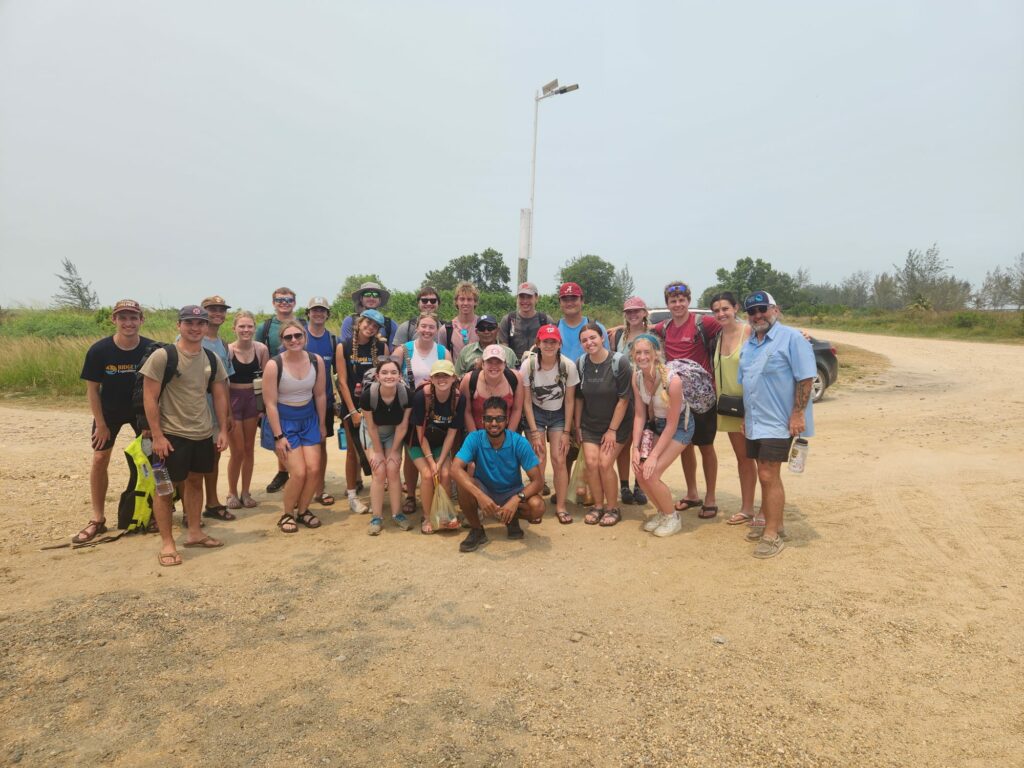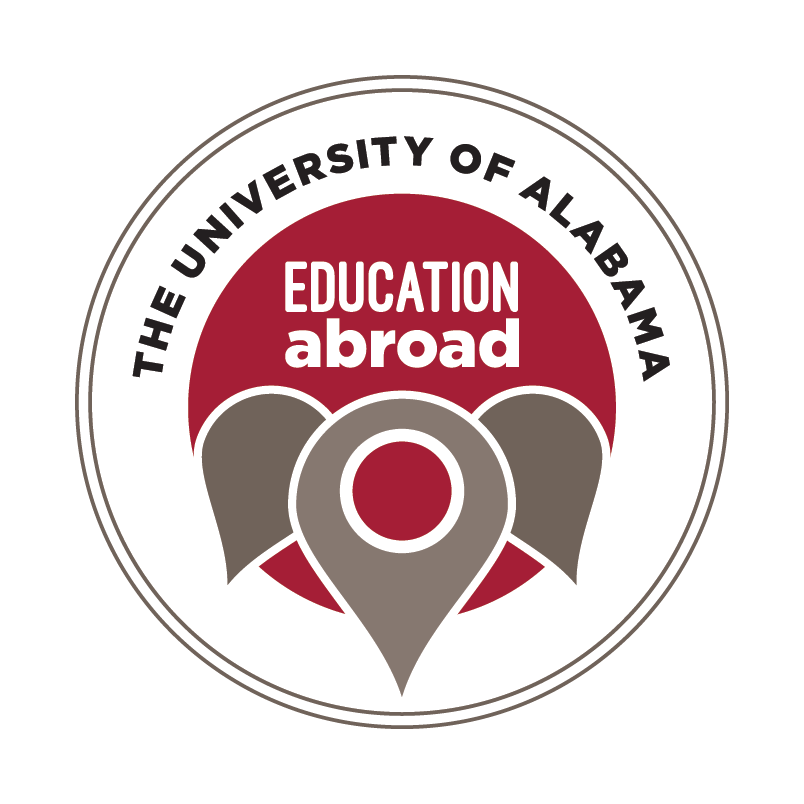My first impression when I arrived in Belize was that it was very hot; I suddenly got apprehensive about the weather and if I would be in miserable heat the entire time. The first night, I asked my TA, Kaitlyn, about it, and she assured me when we got to the water, the breeze would pick up, and I would feel better. When I first got off the plane, I saw another girl in an Alabama shirt and asked if she was part of the trip; she was so making it through customs was easier. We then met the group outside, and I became concerned about fitting in and making friends. I was worried I would not fit in with so many new people of different ages, majors, and backgrounds. When we left the airport, we went to our first location, Las Amigos, for lunch; I tried chicken stew and rice. The food was terrific. It was different eating outside and seeing the farm from where the food came from; it also tasted more authentic than anything in the States. The photo from lunch is posted below.

UA in Belize, we stayed in three different places: Lime Caye, Big Falls, and South Water Caye. My favorite location was Lime Caye. We stayed there the first five days we were gone. There was no cell phone service, and the girls stayed together in a big house. I felt one with nature and made some lasting bonds with the group. Getting rid of technology required us to focus on who was in our group to talk to and get to know. During big falls, my favorite part was interacting with the citizens of Belize. Getting to know and understand how they live was a life-changing experience. It put in perspective how much we take advantage of the U.S. South Water, where we did most of our academics and prepared to present. There was AC for the first time since I was in Belize, which was nice. I will miss the most are the people and the food. Belize is a life-changing experience, and I will never forget it.
I took GY 450 and BUI 301 for academics, both taught by Dr. Steinberg. I had 21 classmates; since this was a UA study abroad, the class was taught like most Alabama classes. During the first two weeks, we spent the morning and afternoon snorkeling, laying transects, and researching what we found in the textbooks provided. Once we had an internet connection, we could research online and form our presentations for the final. I worked closely with a classmate, Elizabeth, researching diseased coral in the Caribbean. We would lay 30-foot transects and measure depth about eight times daily in different coral reefs. We would have a lecture at night about other species and environmental effects. Being able to research hands-on and learn through textbooks made the topic even more realistic than any lecture class. As an accounting major, I knew little about marine life, but with the help of the TAs, classmates, and professor, I learned so much about environmental science.
We explored several fascinating locations under the guidance of Dr. Steinberg. We visited Lime Caye, Big Falls, and the ancient cities of Lubaantun and Nim Li Punit. In a local town, we participated in a tree-planting initiative. We swam at a creek near a Mayan cave and snorkeled in coral reefs and waters as deep as 11,000 feet at the coral drop point. We also enjoyed traditional Belizean food throughout our journey. This incredible experience was shared with my classmates, TAs, and professors, creating unforgettable memories and deepening our understanding of Belizean culture and natural beauty.
During our visit to Lime Caye, we met the owners and their 10-year-old son, Marcel. Although Marcel could not read or write, his knowledge of survival far surpassed that of most adults in the U.S. He could identify plants and wildlife and had an impressive understanding of the local way of life. While tree planting, we encountered many Belizean citizens who communicated with us in their native language, a blend of English and Spanish. Everyone we encountered could speak to us in English but then would talk to each other in native tongue. At the cocoa farm, we learned that the local lifestyle still adhered to traditional gender roles, with men as hunters and women as gatherers, a stark contrast to life in the U.S. Despite having so little, the Belizeans’ we met were incredibly happy and welcoming, always smiling and eager to share their culture with our group.
During my trip, my senses were constantly engaged by the vibrant surroundings. Visually, I was immersed in abundant wildlife, diverse plant life, and a way of living entirely different from my own. The food taste was incredibly authentic, with none of it processed. Often, we ate fish that we had caught that very morning. The nights were remarkably silent, devoid of car engines and city noise, punctuated only by the call of a Nightjar bird. The smell of the ocean lingered most nights, and each morning, I awoke to the enticing aroma of breakfast being cooked in outdoor kitchens.
As I prepared to return home, I packed my belongings the night before, including the souvenirs I had collected from the traditional Mayan villages and the sea biscuit I found in the ocean. Reflecting on my experiences, I decided to donate my snorkel gear to the island, hoping future visitors would benefit from it as I did. Though I am eager to reunite with my family, the past 18 days have been fantastic—a life-changing adventure I will always treasure. I am deeply grateful for this journey and am excited to share my stories and experiences with everyone back home.

